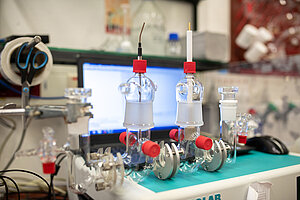An international team of researchers has developed a new mechanism to protect enzymes from oxygen as biocatalysts in fuel cells. The enzymes, known as hydrogenases, are just as efficient as precious metal catalysts, but unstable when they come into contact with oxygen. Therefore, they are not yet suitable for technological applications. The new protective mechanism is based on oxygen-consuming enzymes that draw their energy from sugar. The researchers showed that they were able to use this protective mechanism to produce a functional biofuel cell that works with hydrogen and glucose as fuel. (<link http: news.rub.de presseinformationen wissenschaft external-link-new-window internal link in current>Quelle: RUB)
Together with colleagues from the <link http: news.rub.de wissenschaft external-link-new-window internal link in current>Ruhr University Bochum and the <link http: www.itqb.unl.pt research biological-chemistry bacterial-energy-metabolism external-link-new-window internal link in current>University of Lissabon, <link internal-link internal link in current>Prof. Lubitz, emeritus director of the MPI CEC, published a paper with the results in the journal Nature Communications.
Detailed information about the paper in the <link http: news.rub.de presseinformationen wissenschaft external-link-new-window internal link in current>press release of the RUB.
Adrian Ruff, Julian Szczesny, Nikola Markovic, Felipe Conzuelo, Sónia Zacarias, Inês A.C. Pereira, Wolfgang Lubitz, Wolfgang Schuhmann: A fully protected hydrogenase/polymer-based bioanode for high-performance hydrogen/glucose biofuel cells, in: Nature Communications, 2018, <link https: www.nature.com articles s41467-018-06106-3 external-link-new-window internal link in current>DOI: 10.1038/s41467-018-06106-3

